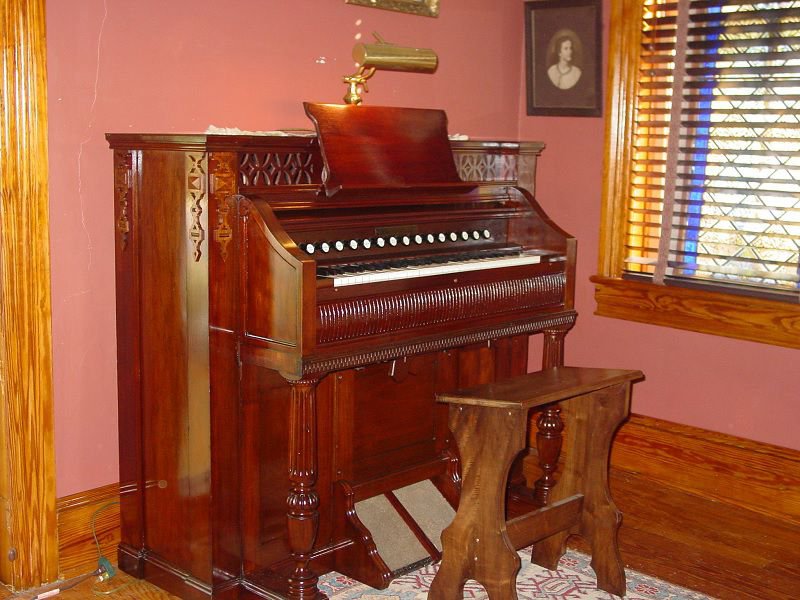Back to list view
Comments and pics for Estey style D salon organ. At least that''s what Fritz called it, and gave it a date of ca. 1908, which fits this serial number.
The octave coupler has been divided across two drawknobs, but is upward-coupling. The sub bass is 17 notes, C-E, and then the Clarionet 16ft takes over. Of course, the transition is not seamless, because the sub bass is much heavier.
The stops use the same names bass and treble, there are 3 @61 note sets at 8ft, one at 4ft, and a double-set celeste at 2ft. All together 421 reeds.
This one was sold originally in a music dealer in Breslau Germany, named J. Grosspietsch (Jnh. R. Heckel, hoflieferant) according to the affixed brass plaque.
It sustained damage, presumably during the battle/siege of Breslau. There were 4-5 bullet holes, and some old repair where bullets or shrapnel damaged the vox humana, sub bass chest, swell,and sound board. There are 4 bullet entry points on the case. Those, and the even more dramatic exit holes have been patched with wood all save for one (one entry hole still has the plastic wood stuff in it). I personally dug pieces of iron shrapnel and crushed glass out of the "bullet entry" side of the cabinet.
The back is black-painted wood panels, this was designed to hug a wall, but the flat top (non-opening) is original. The only sound grilles are to either side of the music desk. This fretwork was re-created, because of the war damage; one bullet went right through it sideways, before entering the swell and soundboard.
Pitch is A438, Bass/treble break is at keys 24/25
The octave coupler has been divided across two drawknobs, but is upward-coupling. The sub bass is 17 notes, C-E, and then the Clarionet 16ft takes over. Of course, the transition is not seamless, because the sub bass is much heavier.
The stops use the same names bass and treble, there are 3 @61 note sets at 8ft, one at 4ft, and a double-set celeste at 2ft. All together 421 reeds.
This one was sold originally in a music dealer in Breslau Germany, named J. Grosspietsch (Jnh. R. Heckel, hoflieferant) according to the affixed brass plaque.
It sustained damage, presumably during the battle/siege of Breslau. There were 4-5 bullet holes, and some old repair where bullets or shrapnel damaged the vox humana, sub bass chest, swell,and sound board. There are 4 bullet entry points on the case. Those, and the even more dramatic exit holes have been patched with wood all save for one (one entry hole still has the plastic wood stuff in it). I personally dug pieces of iron shrapnel and crushed glass out of the "bullet entry" side of the cabinet.
The back is black-painted wood panels, this was designed to hug a wall, but the flat top (non-opening) is original. The only sound grilles are to either side of the music desk. This fretwork was re-created, because of the war damage; one bullet went right through it sideways, before entering the swell and soundboard.
Pitch is A438, Bass/treble break is at keys 24/25
| Information | |
|---|---|
| ROS Reg No. | 5686 |
| Date Registered | 9/21/2015 |
| Views | 50684 |
| - | |
| Serial | 365111 |
| Manufactured Date | 1908 +/- |
| Case Style | Flat Top instrument |
| Maker Location | Brattleboro, VT |
| Model | Style D Salon |
| Knee swells | Yes |
| Wood | Walnut |
| Keys | 61 |
| Manual(s) | 1 |
| Range | F-F |
| Stops | 15 |
| Pump method | Foot, suction |
| Stops |
|---|
| Bass Coupler (up) |
| Sub Bass 16'' |
| Oboe 8'' |
| Vox Jubilante 8'' |
| Diapason 8'' |
| Flute 4'' |
| Harp AEolienne 2'' |
| Vox Humana |
| Harp AEolienne 2'' |
| Flute 4'' |
| Diapason 8'' |
| Vox Jubilante 8'' |
| Oboe 8'' |
| Clarionet 16'' |
| Treble Coupler (up) |
